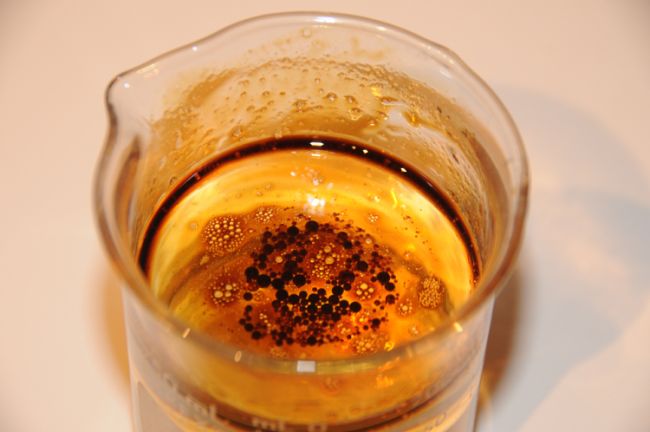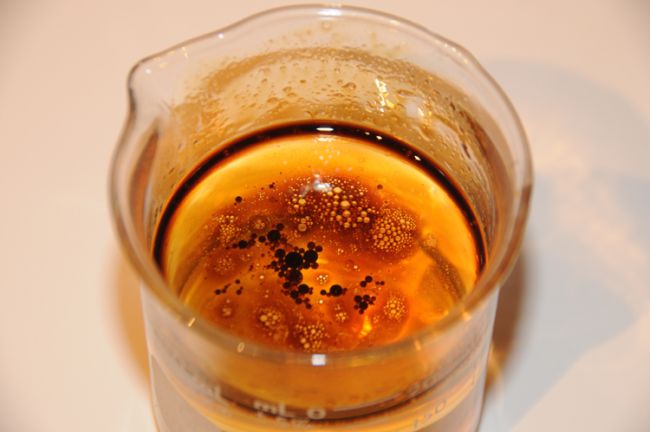Moderator: 3ne2nr Mods
Best Regards,
Greg Theisz
Southeast Regional Manager
Cell 713-253-3422Fax 210-568-2940
gtheisz@royalpurple.com
We recently had a consumer provide us with a coolant sample that he thought had been contaminated with motor oil from a blown head gasket. We performed an analysis, and found it wasn't motor oil. It was polysiloxane polymer (i.e. silicone) from Red Line Water Wetter. He had been using this product for several years, adding a couple bottles per year.
Seeing this prompted us to look into the issue further in the controlled environment of our coolant test lab.
We setup our ASTM D2570 Simulated Service coolant test rig, and ran Water Wetter through repeated heat/cool cycles. We found that after 8-10 cycles, the polysiloxane polymer become completely insoluble. After another 5-6 cycles, it turned brown, and began coating the inside of the radiator. After another 15-20 cycles, it turned darker brown, and in the high heat area of the system became thicker in consistency -- almost like molasses.
As mentioned in a previous report on this topic, Red Line uses polysiloxane polymer as an antifoam ingredient in their Water Wetter formula. This is "old technology," as there are now far more sophisticated antifoam ingredients available for coolant. The problem with polysiloxane is that it is only marginally soluble in water, and polymerizes through repeated heating/cooling cycles.
Have a look at the attached photos. Two of them are glass beakers containing the Water Wetter/water solution drained from our ASTM test rig at the conclusion of the test. The other one is the coolant reservoir of the consumer who needlessly rebuilt his engine after using Water Wetter.
As you can see, this material looks a lot like motor oil. It coats everything it comes into contact with. It would take a lot of flushing to completely remove this from a cooling system. It's pretty nasty stuff. I can tell you, it took plenty of work to get it out of our ASTM test rig!
I have heard through the grapevine that the chemist who originally developed Water Wetter is no longer at Red Line, and none of their existing technical staff has any background in the area of coolants. For this reason, they are probably unable to update their formula to any newer types of technology. And of course, they are not members of ASTM, so they may not have any access to research or updated test methodology.
I share this info with you for two reasons:
1) Some uninformed consumers may errantly assume this material is motor oil in their coolant from a blown heat gasket, causing them to perform a costly motor teardown that is completely unnecessary.
2) There may be consumers who use Red Line Water Wetter before using Purple Ice. We certainly don't want them to think that Ice caused this. For this reason, I think our research on this subject may prove helpful at some point.
We have full documentation to back all of this up. And of course the web is filled with similar reports. If you Google the words "Water Wetter Brown" you find scores of them. Feel free to use this info however you may see fit.
-Jay



Strugglerzinc wrote:Now what? Purple Ice?
I've said this many times, I will repeat now for those who don't use the search button again
You folks with the gunk get it because you use watter wetter only in the final coolant load. The softer coolant with watter wetter (or dishsoap, etc.) will reach such places where your flush haven't cleaned at all and that's why your engine is dirty. The watter wetter pulls the gunk out which is indication it works - but you didn't use it properly.
Forget flushing your coolant system with a garden hose, etc. Just buy a truckload of distilled watter, always put watter wetter (or dish soap) in it and flush the system this way. Do this 4-5 times - distilled water + watter wetter, drive for half a hour, drain, and repeat this 4-5 times. And then put the final coolant + watter wetter.
I flush my car the proper way and I have zero gunk and my coolant always is clean (like new).
If you get gunk with the watter wetter - this means your engine is dirty and needs good cleaning with distilled water and watter wetter.
Never put watter wetter (or dish soap, etc. softeners) in the coolant if you flushed the system before that without using the same ratio of softener and water! If you want to use softener at the end - use enough amount or more when flushing.
Groovemaster wrote:OK, I have my bottle for sale if anyone wants it!!!
W2J wrote:^ vega do you still own d gallant? filling water alone with a cast iron bottom end will result in rusting there isa reason for coolant, my advise AMSOIL, Peak or Glycoshell.
Big Z wrote:Why my name calling?
V2NR 3.0 wrote:Big Z wrote:Why my name calling?
Cause you are "Big" in Zee dance
Big Z wrote:Why my name calling?
Big Z wrote:I fail to see how a thread about my experience with the product (and a positive one at that) has anything to do with this thread.
You breathe air, I breathe air... does that mean I should move into your house?
Nothing personal bro.. just logic.





Users browsing this forum: No registered users and 1 guest